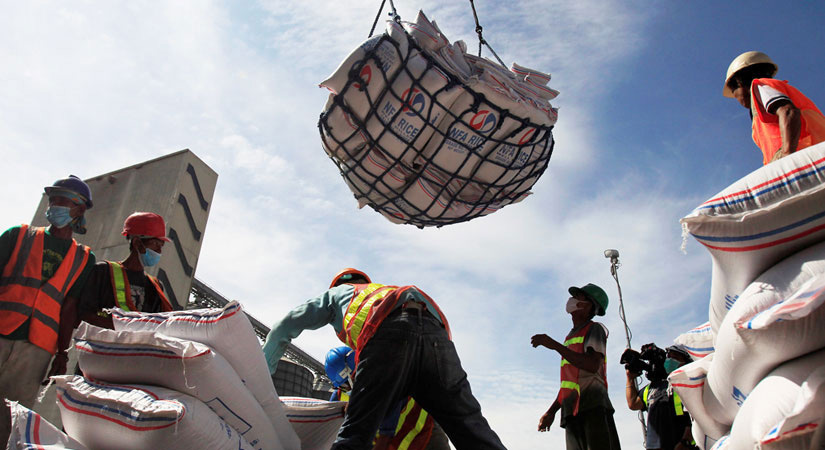THE justification for lowering of tariff rates on imported rice under Executive Order (EO) No. 135 has no basis and is “deceptive,” because there is no current shortage of imported rice, the Federation of Free Farmers (FFF) said.
Raul Q. Montemayor, FFF National Manager, said in a statement Sunday that the EO amounts to a “cruel joke” on farmers, noting that importers are already free under Republic Act No. 11203 or the Rice Tariffication Law to import rice from any country as long as quarantine regulations.
“Aside from Vietnam and other ASEAN countries, we have been consistently importing from nine other countries, including India and Pakistan, and more recently China. Similarly, there is no urgent need to augment our rice supply,” Mr. Montemayor said.
“The Philippine Statistics Authority (PSA) pegged our March 1 national rice inventory at 2.08 million metric tons (MT), or only 4.5% lower than last year. This stock level will have already been augmented by the recent dry season harvest,” he added.
Late Saturday, the President’s spokesman Herminio L. Roque, Jr. announced that President Rodrigo R. Duterte signed EO 135 which lowered the tariff on rice imports to 35% from 40% for one year.
According to Mr. Roque, the move to lower rice tariffs is to “diversify the country’s market sources, augment rice supply, maintain affordable prices, and reduce pressure on inflation.”
In a separate statement Sunday, Samahang Industriya ng Agrikultura Chairman Rosendo O. So said the decision to lower rice tariffs should also have been evaluated by the Senate and the House of Representatives.
“EO 135 was issued while everyone else was working on the pork tariff compromise,” Mr. So said.
FFF’s Mr. Montemayor said that unlike pork, there is no emergency to be addressed in terms of rice supply. He also noted the timing of issuing EO 135 over the weekend, just before the resumption of Congress on May 17.
“This is another slap in the face of the legislature. The power of the President to adjust tariffs is an authority delegated by Congress to allow the executive primarily to address urgent problems when Congress is not in session,” Mr. Montemayor said.
PORK IMPORTS
On Saturday, Mr. Roque also announced that Mr. Duterte signed EO 134, which sets the tariff on pork imports within the minimum access volume (MAV) quota at 10% for three months and up to 15% in the following nine months. The order also sets the tariffs of pork imports exceeding the MAV quota at 20% for three months, rising to 25% in the succeeding nine months.
EO 133 increased the tariff rates set by EO 128, signed on April 7, which had lowered the tariff of pork imports within the quota to between 5% and 10%; for imports beyond the quota the rates were set at between 15% and 20%.
Before EO 128, in-quota pork imports paid 30% tariff while out-of-quota pork was charged 40%.
Mr. Duterte also signed EO 133, which raised the MAV allocation to 254,210 MT from the previous ceiling of 54,210 MT, and Proclamation No. 1143, which declared a state of calamity due to the African Swine Fever (ASF) outbreak.
Edwin G. Chen, Pork Producers Federation of the Philippines, Inc., said in a mobile phone message that the government still has a lot of work to do to help pork producers.
“There is still a lot of work (to be done) like the Agricultural Commodity Examination Area (ACEA) inspection facility and the use of calamity funds by local government units in controlling ASF,” Mr. Chen said.
He also cited the need for “strict biosecurity protocols for (animals) coming in for repopulation. Backyard hog raisers as well as commercial hog farms should adopt an elevated biosecurity protocol before we allow them to repopulate (their herds) to avoid recurrence and resurgence of ASF,” he added.
Jesus C. Cham, Meat Importers and Traders Association president, said in a mobile phone message that the adjustment in tariff rates will most likely result in higher retail prices.
“With the compromise raising duty rates and lowering MAV plus, going forward we will see higher landed costs. New arrivals will be subject to higher duty. Also, looser quarantine restrictions may see more demand and consumption. There will be more upward pressure on prices,” Mr. Cham said.
“Landed cost in the next three months will increase by 5%. I believe this can still be accommodated at current retail prices. After three months another 5% is added. However, this will happen around the ‘ber months.’ So, the outlook is increased demand and reduced supply. By that time the market will be more accepting of higher prices,” he added. — Revin Mikhael D. Ochave

